A look at life for students and professors at the only Serbian-language University in Kosovo, with a “temporary” seat in North Mitrovica.
The former Branko Radicevic school in North Mitrovica is weathered and clammy inside. It is no longer a school. Instead, it houses two Serb refugees who fled Croatia during the war in 1995. The building abuts the university’s student dormitory complex. Right next door, students flit between classrooms and cafes. Everyone runs around the place, but the building remains, weathered, housing the helpless.
For Milan Dobric, a graphic design student, this is one of his abiding images of living and studying in North Mitrovica at the “University of Pristina temporarily settled in Kosovska Mitrovica.”
In spite of all its shortcomings, the university, whose name is a mouthful, still remains the only institution in Kosovo where higher education is available in the Serbian language. It comes as no surprise, therefore, that this university is one of the symbols of the Serb community in Kosovo. Its approximately 7,500 students study in its 10 faculties.
As we sit in the cozy North City restaurant, Dobric shares his stories of living and studying in North Mitrovica. The calmness of the residential part of the campus is unusual. Students are either in classes or spending their breaks in nearby cafes. Soho, Krim, Incognito, Cuba Cafe, Skloniste (Serbian for “shelter”), and Akvarijus are some of the most popular of the many cafes where students spend their free time.
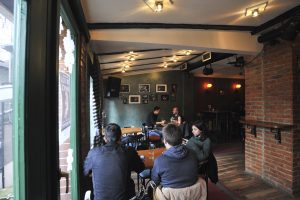
Cafe Soho in North Mitrovica. | Photo: Atdhe Mulla
All the important sites are within walking distance of the campus or the complex of student dormitories. Milan points out that this is one of the advantages of studying in Mitrovica: the students form stronger bonds than they might in large cities. This is also a drawback, since the number of activities for students in such a small space is insufficient.
Dobric could not completely explain why the old building and the displaced persons are part of his mind’s image of the university and of Mitrovica. But many of the city’s residents, and indeed its institutions, have been contending with displacement since the 1998-99 Kosovo War, and even before.
The history of the university is emblematic of this: In the past eighteen years, it has been relocated and shuffled around several times. Even today its headquarters in Mitrovica are still considered “temporary.”
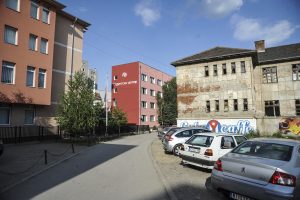
Near the Student Center in Mitrovica. | Photo: Atdhe Mulla
The University of Pristina was founded on November 18, 1969. Faculties, which are something between university departments and “colleges,” which had been located in Prishtina, became part of the university, while other colleges and vocational schools across Kosovo joined later on. Lectures were held in both Albanian and Serbian until the academic year 1991/1992, when the education system was split. Departments of the University of Prishtina that were in Serbian kept working within the Serbian educational system.
Meanwhile, the majority of Albanian professors were fired, and classes in the Albanian language ceased. As a response, Kosovo Albanians organized a parallel education system, including the University of Prishtina, which functioned illegally.
After a deal struck between former Yugoslav President Slobodan Milosevic and Ibrahim Rugova of the Democratic League of Kosovo on September 1, 1996, with mediation of the Community of Sant’Edigio, an agreement was signed which instituted a division of university spaces. On March 23, 1998, measures were taken to start implementing the agreement, but it never came to pass.
Student life in pre-war Prishtina
A few years prior, in 1996, Tatjana Kompirovic started her undergraduate studies in Prishtina. Looking back at her student days, she remembers her time in Prishtina fondly, and says the teaching was great but the living conditions in the student dorms were less than optimal.

Student dormitories at the University of Pristina; photo taken during the 1990s, exact date unknown. | Photo courtesy of Tatiana Kompirovic.
Kompirovic, who was a Philosophy junior in 1999 during the height of the Kosovo war, was so adamant about finishing her studies that she tried to find professors to pass exams even in April and June in the midst of the NATO bombing campaign.
When the war came, Kompirovic had to move out of her dormitory in Prishtina and went back home to Zubin Potok, in the very north of Kosovo. She refused to skip her exams, so she would drive with her classmate Nemanja to Prishtina.
“Nemanja was even lucky and managed to find some of his professors that time. Some had left; the transportation lines were already irregular. The regular lines had already been cut. People found various ways of getting from point A to point B,” Kompirovic said.
“Nemanja would say ‘I’m going tomorrow,’ and I would ask him to let me drive with him,” she recollected. “We probably did that because we were young.”
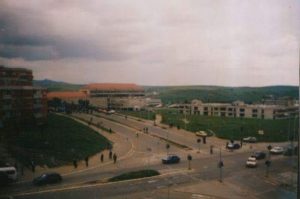
The Technical Faculties building at the University of Pristina; photo taken during the 1990s, exact date unknown. | Photo courtesy of Tatiana Kompirovic.
In June 1999, demographics in Prishtina drastically changed. Many Albanians had fled or were expelled from the city and sought refuge in Macedonia, Albania or elsewhere. In total during the war, 90 per cent of Albanians living in Kosovo were temporarily displaced. By the end of June 1999, some 38,000 Serbs fled Prishtina as well, never to return again.
“There was literally not a living soul in the streets. Suddenly there were sirens in the middle of the city. Everyone was fleeing the streets and the whole place became desolate. There was none of that old ruckus in the streets, not as much of a ruckus as it is today naturally, but still, the city was the largest in our whole region. We would then say ‘Let’s go back home, where did we come, why did we come,’” she added.
The June exams and the hunt for professors were Tatjana Kompirovic’s last student days in Prishtina, but not only for her. The same was true for about another hundred of her fellow students from the Department of Education and an additional 16,000 students of the University of Pristina.

The Technical Faculties building at the University of Pristina; photo taken during the 1990s, exact date unknown. | Photo courtesy of Tatiana Kompirovic.
In October, the university held exams at the higher school (known as ‘Viša škola,’ in Serbian) in Zvecan for students of the philosophy department, but most students did not show up for exams: more than 200,000 Kosovo Serbs fled in fear of reprisals, many of them moving to Serbia.
“Most of the people had moved. They became refugees. People who lived in this area, in northern Kosovo, were mainly those who showed up for the exams,” Kompirovic said.
Eventually, she managed to finish her exam, and now she is a professor in the Faculty of Philosophy at the relocated university.
The Serbian-language University relocates
From that point on, the Serbian-language university was in exile. After the war, the Albanian academic staff returned to the University’s original facilities in Prishtina and continued teaching under the banner of the University of Prishtina, which would later adopt the name of “Hasan Prishtina.”
In 1999, the Serbian-language university was flung in multiple directions. The Technical Sciences Faculty had a branch for mining that was already in North Mitrovica, and that year the whole department moved to North Mitrovica. The Civil Engineering and Architecture department and Engineering and Electrical Engineering department were also transferred there from Prishtina. The Economics and Philosophy faculties as well as the business vocational school from Fushe Kosove were relocated to Blace, a small town at the foot of Mt. Kopaonik. The Natural Sciences and Mathematics faculties, the Medical School, and the College of Agriculture went to Krusevac, in Central Serbia. Varvarin became home to the College of the Arts, while Vranje became the seat of the Law School. The faculties of Physical Education, Education, and the Higher School of Economics continued operating in the Municipality of Leposavic.
Two thirds of the educational space is rented and we treat it as such. We simply consider it as a space we rented out so we can organize theoretical and practical education in normal conditions. Former Rector Blagoje Nedeljkovic.
The students from the Pristina Student Services Center were placed on one floor of an elementary school in Blace. Although the housing was somewhat better, with private bathrooms, it could still not distract them from the sorrow over displacement.
“There could not possibly be a replacement for the most important thing – the people you missed. It all looked sad to us. You ask yourself how you feel. You feel OK, but the people that ought to be around are no longer there. That was the first impression,” Kompirovic said of those student days spent in Blace.
“You have three or four people you know and with whom you built some sort of a relationship during the course of three years. Everyone else remains beyond your reach, far away.”
A decision of the government of Serbia in 2001 relocated the university to Mitrovica, which was to become its seat. At the same time, it was given the name “University of Pristina temporarily settled in Kosovska Mitrovica.” Step by step, all faculties that were part of the university returned to Kosovo. Some departments are located in Leposavic and Zvecan, in addition to North Mitrovica. As the university moved, the professors, administration workers, and students did too.

Tatjana Kompirovic, professor at the Faculty of Pedagogy. | Photo: Facebook
“We recently gave a send-off to a cadre of professors into retirement who remained faithful to the university and our department from the moment it was founded. Although they had the chance to go elsewhere, they chose to stay here,” Kompirovic says.
The University of Prishtina in Prishtina is accredited by the Kosovo Ministry of Education, while the University of Pristina with a temporary seat in Mitrovica is accredited by Serbia and not recognized by the Kosovo authorities.
According to Blagoje Nedeljkovic, who was the university’s rector at the time of the interview, a major problem the university faces is the lack of a permanent ownership of property.
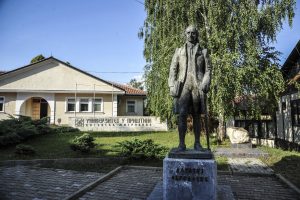
A monument of “Dositej Obradovic” in front of the Rectorate. | Photo: Atdhe Mulla
“We met the minimum criteria for the accreditation of each faculty that is part of the university,” former Rector Nedeljkovic said. “That, of course, was not enough. Two thirds of the educational space is rented and we treat it as such. We simply consider it as a space we rented out so we can organize theoretical and practical education in normal conditions.”
Sixteen years after the university returned to Kosovo, the lack of teaching space is a problem that weighs heavily over both the students and the professors. The Faculty of Philosophy is located in a prefab building, which it shares with the Faculty of Philology. The lessons are organized in such a manner that students of one faculty attend classes for a week, while the others have a week off. Yet, these two faculties are of the rare ones to have the administration and the classrooms in the same shared space.
The Faculty of Natural Sciences and Mathematics and the Faculty of Law share their teaching space with the Technical School, which is also used by students from the high school and the Faculty of Economics.
The school draws Serbian-speaking students from all over Kosovo and southern Serbia including Kursumlija, Blace, Novi Pazar, and even Belgrade and Montenegro at various departments. More affordable conditions, tuition fees, and housing are some of the reasons why the students decide to choose this University.
“Students of technical sciences, the arts, natural sciences, for example, have much less practical work,” said Dobric, the graphic design student. “I think that a bit more should be invested in the future… More work is done according to the old educational programs and new teaching methods are not implemented,” he said. This is his second degree, since he already has the equivalent of an Associate’s Degree from the Higher School of Technical Sciences in Zvecan.
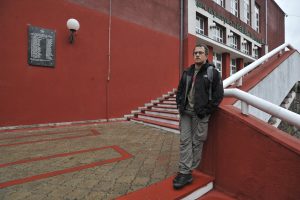
Milan Dobric, pictured here a the Trepca Cultural Center in Zvecan. Dobric, from North Mitrovica, is a student of the Faculty of Arts. | Photo: Atdhe Mulla
The professors think the academic and work conditions are not ideal, especially when comparing today’s educational space with the one used while the university was located in Prishtina.
“What is important is that we have yet again gathered together in a city such as Kosovska Mitrovica and that we aim to create, as close as possible to the aforementioned conditions, new conditions in this city,” says Nedeljkovic, using the name for Mitrovica used by Serbs.
Although the name of the University emphasizes that North Mitrovica is only its temporary location, today this is seen as mostly symbolic. Kompirovic misses the days of her youth, but does not see herself or the University returning to Prishtina.
“I love the Prishtina of my memories. That whole thing was nice. I’m not a part of that anymore and love for that era is all but gone. What remains are the emotional memories of that city and those days. This, however, does not mean that I have to grieve over those times and hope that I could see myself there in any form,” said Kompirovic.
Dobric, 26, said he has known the university to be in Mitrovica for as long as he remembers.
“As far as I can personally account for, it has been in Mitrovica. Now I simply cannot tell how long will this location be a temporary one,” he said.
Former Rector Nedeljkovic said that one place it will not be moving to is Prishtina: “As far as the Serbs are concerned, Prishtina remains a forbidden city,” he said.
For Serbian speakers, there is not much choice: two decades since the end of the war, there is still no Kosovo institution of higher education available in Serbian.
Communication between officials of the North Mitrovica University of Pristina and the authorities in Prishtina goes through the European Center for Minority Issues, ECMI. The international NGO serves as an intermediary in the process of degree verification between the university in northern Kosovo and the Kosovo Ministry of Education. This process is the result of a deal on mutual recognition of diplomas reached by Belgrade and Prishtina in Brussels. The verification encompasses a check of the validity of degrees issued at the university, which has its seat in Mitrovica. So far, 633 degrees from this university have been verified, while a total of 1,113 requests have been submitted. The degree verification enables the graduates to find employment in Kosovo’s public institutions, take professional exams, among which is the bar exam.
Student life in North Mitrovica
While Yugoslav Mitrovica was known for its music scene and prosperous living standards provided by the Trepca mines, today the city’s name is a byword for the divisions in Kosovo between Serbs and Albanians. It is a divided city, with Albanians mostly living south of the Ibar river, which slices the city into two municipalities. It is a frequent subject of discussion in the ongoing debates between Belgrade and Prishtina in Brussels, and was the site of several controversial events this year, including attempts earlier this year to build a wall on the north side of the bridge.
Still, for many of the students, the Municipality of North Mitrovica is a comfy place, with both advantages and shortcomings of its own kind.
“Mitrovica is a small town, which is both positive and negative. There is something for everyone – for those who like sports, those who make art, or even those who like the nightlife,” says Adila Kahrovic, a geography student from Sjenica, a town in Serbia’s Sandzak region known for its white cheese.
Aleksandra Radulovic, a student of architecture who was born in Prishtina, is currently preparing her undergraduate thesis. After she attended all the classes, she went back to Belgrade, where she has been living since the war.
The entire political situation affects the atmosphere among students, natives, the university, and the professors. Milan Dobric, student.
“Mitrovica is a city in which you are never alone. There is always someone with whom you can grab a cup of coffee, go for a beer, to hang out, take a walk. You make friends here rather easy. I spend much more time outside with my friends here than I do here in Belgrade,” Radulovic said.
Although they have plenty of positive experiences while studying in Mitrovica, the students do see the difference in comparison to larger university centers.
“Mitrovica is a small town. The entire political situation affects the atmosphere among students, natives, the university, and the professors,” says Dobric. “Since Mitrovica is such a small place, unlike Belgrade, it does not have too much to offer to the students.”
“Mitrovica has many students and is largely dependent on them,” he adds.
Unlike the students who live in Kosovo or in the immediate area, there are those who set off for Mitrovica – into the unknown – filled with prejudice.
“My journey here was marked by fear of what I was about to see because my head had been filled primarily by the media. The people soak it in and get the picture as if this were Vietnam in the ’50s, that bombs are dropping all over the place. I certainly did expect that. But then I saw that life functions normally,” says Stefan Stevanovic from Batocina, a municipality close to Kragujevac. Stevanovic completed his undergraduate studies at the College of the Arts in Zvecan.
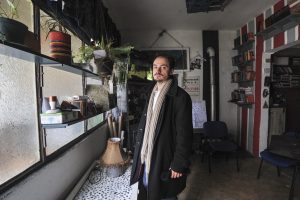
Stefan Cerovina, former student at the Faculty of Psychology. Cerovina is one of the founders of the cultural shelter Bes(i)Misao. | Photo: Atdhe Mulla
He likes coming back to Kosovo, adding, “I did not spend four days or four hours here. I spent a total of four years, saw all sorts of things, met all kinds of people. Some of them are my friends, some of them are not, while some of them are my associates and friends. It’s all a happy little commune.”
We find Stevanovic in the Bosnjacka Mahala/Mahalla e Boshnjakeve neighborhood in the Akvarijus Private Cultural Center, where he works as a teaching assistant in a small studio. He has been helping prepare an exhibit titled “The Left Side of the Mind,” in which art students exhibited paintings about human mental states. He jokingly said that the works of his colleagues are not so good, but that he still supports the exhibit. Even with the original Mitrovica-related prejudice, he says that he came here because he does not harbor the fear of the unknown.
“This background of the student life here – I think it’s the same everywhere. The students are penniless people who always want to do something and fulfill their purpose through something. Even then, some of it ends up right, and some of it not,” said Stevanovic.
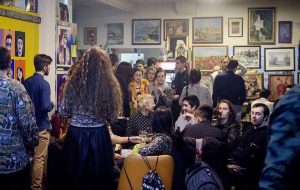
Opening for the “Left Side of the Mind” exhibit. | Photo: Photo: Galery Akvarijus, Haris Licina.
Today he looks at Mitrovica from a distance of about 300 kilometers, since he spends the majority of his time in Belgrade where he is studying for a Master’s degree. Regardless of all the advantages of a big city, he says that Mitrovica has a soul, while everything in Belgrade is, according to him, “sterile.”
“The space on its own, as a geographic expanse, has a soul. Out there everything is cold and inaccessible. In a way, it’s untouchable,” Stevanovic said “I can only characterize these four years of my studies here as a Kusturica movie or a Dali painting.”
For students who stay in North Mitrovica, alternative and avant-garde places are getting increasingly popular. Besides the Akvarijus Gallery, one of the more popular places is the Bes(i)misao Cultural Shelter (a play of words in Serbian between “pointlessness” and “rage and thought”), housed in an abandoned garage. The casual passer-by who goes from the Faculty of Technical Sciences towards the new bus station is met by a plethora of flowers which hang from the roof. The space of about twenty square meters is home to a couch, armchair, a few chairs, a bar, TV, and several young people from different towns, who all dress differently, have different hairstyles and worldviews.
“I don’t think there’s too much rage. I think there’s too little thinking in rage. People tend not to think about it. We decided to deal with culture, science, and the arts and use the energy in that direction. Senselessness appears to be not a characteristic of Mitrovica exclusively, but the world, too. This kind of an emotion is surely strongly felt here,” said Stefan Cerovina, a former psychology student, explaining the name of this place where various thematic events for students, but also all those who wish to visit the “shelter” are held.
But students complain that there is not sufficient freedom for students in Mitrovica. That is why they try to engage in creative projects.
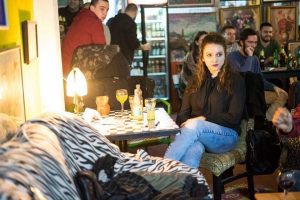
Concert of students and professors from the music department of the Faculty of Arts in North Mitrovica, held at the Akvarijus Gallery on November 30, 2017. | Photo: Galery Akvarijus, Haris Licina.
“If someone raises their hand and wishes to speak out, be different on any front, be it a scientist, artist, or merely a free-thinking individual, and if that does indeed happens, we trample it momentarily because we are so terribly bothered by the success of someone else that we fail to understand it might also partly be our success,” said Stevanovic.
The perspectives of Mitrovica and the university from the beginning of the story, through the eyes of Milan Dobric, the student who was born and raised in this city, are different from the perspectives held by his fellow student, Stefan Stevanovic. If he were to paint something related to Mitrovica and his time spent as a student in this city, that painting would occupy a prominent position at the exhibit. It would, he says, be a scream, with plenty of red which sends a message of its own.
“Do these people scream? Do they long for something? Are they in a hole, trying to get out? This here is nothing but anarchy, an absence of everything, but also, at the same time, presence of everything. It does, however, function as a single organism,” Stevanovic concluded.





